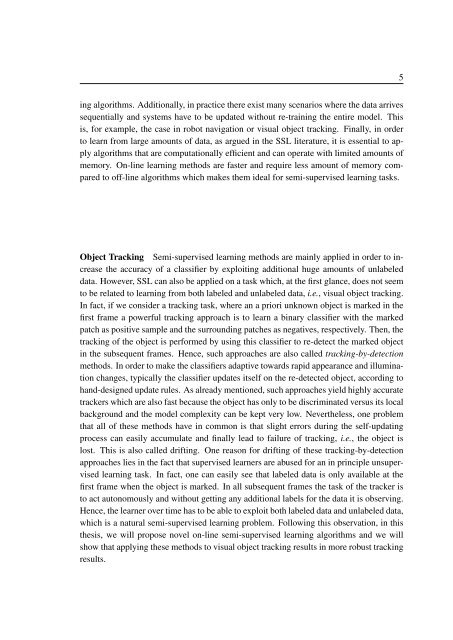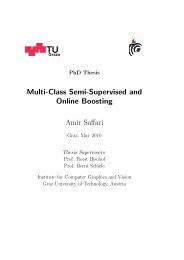PhD Thesis Semi-Supervised Ensemble Methods for Computer Vision
PhD Thesis Semi-Supervised Ensemble Methods for Computer Vision
PhD Thesis Semi-Supervised Ensemble Methods for Computer Vision
Create successful ePaper yourself
Turn your PDF publications into a flip-book with our unique Google optimized e-Paper software.
5<br />
ing algorithms. Additionally, in practice there exist many scenarios where the data arrives<br />
sequentially and systems have to be updated without re-training the entire model. This<br />
is, <strong>for</strong> example, the case in robot navigation or visual object tracking. Finally, in order<br />
to learn from large amounts of data, as argued in the SSL literature, it is essential to apply<br />
algorithms that are computationally efficient and can operate with limited amounts of<br />
memory. On-line learning methods are faster and require less amount of memory compared<br />
to off-line algorithms which makes them ideal <strong>for</strong> semi-supervised learning tasks.<br />
Object Tracking <strong>Semi</strong>-supervised learning methods are mainly applied in order to increase<br />
the accuracy of a classifier by exploiting additional huge amounts of unlabeled<br />
data. However, SSL can also be applied on a task which, at the first glance, does not seem<br />
to be related to learning from both labeled and unlabeled data, i.e., visual object tracking.<br />
In fact, if we consider a tracking task, where an a priori unknown object is marked in the<br />
first frame a powerful tracking approach is to learn a binary classifier with the marked<br />
patch as positive sample and the surrounding patches as negatives, respectively. Then, the<br />
tracking of the object is per<strong>for</strong>med by using this classifier to re-detect the marked object<br />
in the subsequent frames. Hence, such approaches are also called tracking-by-detection<br />
methods. In order to make the classifiers adaptive towards rapid appearance and illumination<br />
changes, typically the classifier updates itself on the re-detected object, according to<br />
hand-designed update rules. As already mentioned, such approaches yield highly accurate<br />
trackers which are also fast because the object has only to be discriminated versus its local<br />
background and the model complexity can be kept very low. Nevertheless, one problem<br />
that all of these methods have in common is that slight errors during the self-updating<br />
process can easily accumulate and finally lead to failure of tracking, i.e., the object is<br />
lost. This is also called drifting. One reason <strong>for</strong> drifting of these tracking-by-detection<br />
approaches lies in the fact that supervised learners are abused <strong>for</strong> an in principle unsupervised<br />
learning task. In fact, one can easily see that labeled data is only available at the<br />
first frame when the object is marked. In all subsequent frames the task of the tracker is<br />
to act autonomously and without getting any additional labels <strong>for</strong> the data it is observing.<br />
Hence, the learner over time has to be able to exploit both labeled data and unlabeled data,<br />
which is a natural semi-supervised learning problem. Following this observation, in this<br />
thesis, we will propose novel on-line semi-supervised learning algorithms and we will<br />
show that applying these methods to visual object tracking results in more robust tracking<br />
results.



